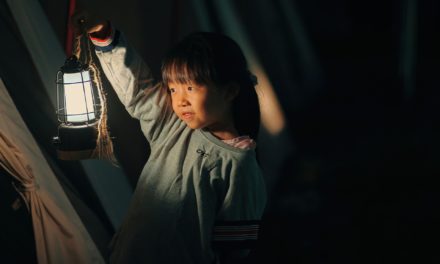I sink into a green armchair next to a window overlooking a row of bungalows in my Chicago suburb. Before picking up my cellphone, I glance outside to see if a pair of cardinals are again feasting on the earthen colored seedpods clinging to a nearby bush. No sign of these scarlet beauties.
I dial into our midday call and press *6 to mute, so my friends won’t hear the plaintive meows of my cat, who mistakes my chair’s arm rest for a scratching pad. My stockinged feet are pressed against my hardwood floor. I sit up tall and rest my hands on my knees, palms up. I am late for our “sit” because I had an urgent work email to answer about a grant deadline. The small brass gong signaling the beginning of our prayer time together has already sounded. To settle myself, I take a couple of deep breaths and enter a shared silence. We are gathering, as we have since the pandemic began, to join in Centering Prayer. It is not conversation, but rather communion we seek.
“God’s first language is silence.” ~St. John of the Cross, 16th century Christian mystic.

I learn that that term “centering prayer” is the name coined by Roman Catholic theologian and monk Thomas Merton for this form of contemplative prayer because it is entirely “centered “on the presence of God. Embraced by early monastics of the Christian Church and later by mystics like John of the Cross and Teresa of Avila, this silent prayer had largely disappeared from practice until a group of Trappist monks revived Centering in the 1970s.
This form of silent praying appeals to me since I live so much in my head, words bouncing around my brain like ping pong balls. It sounds so simple, so easily attainable, but is terribly, maddeningly hard. After two years of practice, I still struggle to figure out what Centering means. But my mission is doomed. This is not a cerebral exercise.
In Open Mind, Open Heart, recognized as a primer of centering prayer, Father Thomas Keating expresses the sacred quest this way: “We cannot know him (God) with our mind, we can only know him with our love.” My mind drifts to a quote from The Little Prince, the classic by Antoine St. Exupery which affirms that the most important life truths we know through our hearts.
“It is only with the heart that we can see clearly.” ~Antoine St. Exupery.

For a lifelong practitioner of Western Christianity, adopting this kind of prayer is like bushwhacking through a rain forest without a machete. I grew up a good Catholic girl, saying rosaries and attending daily mass. But I have also chanted with a Buddhist friend, attempted mindfulness walks, and engaged in guided imagery on retreats. My heart knows centering has no goalposts, yet my anxious mind continues to seek them. How will I know when I experienced communion? Consented to God’s presence? Would a sudden warmth envelope my being? Would I sense a peace beyond human understanding?
During my ‘sit,” the term that we centerers use when we pray, my sought-after silence is constantly broken. The roar of flights to nearby Midway Airport, hum of buses picking up kids at the elementary school across the street, the yowl of my cat eager to be petted. And there is the strange thrum of a mysterious pulsatile tinnitus that causes me to hear my own disembodied heartbeat when all is still.
Random thoughts creep into my head like drones invading foreign airspace. Will my oldest daughter find a teaching job? Did I pay my latest credit card bill? Will I be able to meet this punishing deadline on a federal grant? Following the advice of Keating, I try to gently brush these thoughts away, like flicking a bit of lint off my sweater. Rather than getting upset, I should be grateful for these diversions, because the resulting effort to refocus my prayer represents “a gazillion pathways back to God,” he advises. It is not so much the absence of thoughts, but detachment from them.
“Introduce the sacred word gently, incredibly gently, as if you are laying a feather on a piece of absorbent cotton.” ~Father Thomas Keating

Full disclosure, we centerers have tricks in our back pocket. Like many practitioners, I use a “sacred word” to guide me back to contemplation when my thoughts meander. Mine is “Abide,” inspired by an Elizabeth Strout novel entitled “Abide with Me” that I greatly admire for its moving storytelling about loss and faith.
When my sacred word is not enough to keep me on track, I turn to imagery to help me. I envision a wheat field, its burnished colors reminiscent of a Van Gogh painting. Or a full moon beaming on a calm sea, with barely a ripple on its luminous surface. Even with these visual delights, I sometimes doze off or get dragged back to concerns of daily life.
Keating calls centering prayer is a “process of interior transformation.” Like most centering guides, he advises practitioners to sit for 20 minutes, twice a day. I have never even come close to this threshold. But still I try.
The immediate spiritual consolation that centering brings is not the only benefit. Rather, the most profound impact spills over into mundane daily life. Regular practitioners have reported that they become calmer, less prone to anger, more patient, less anxious. One study of women undergoing chemotherapy for ovarian cancer showed that centering prayer had a positive, healing effect.
I have struggled with bouts of anxiety my entire life, seeking solace from therapists and medication, yoga, mindfulness, and alcohol. During one very anxious chapter when worries about a new job left kept me awake, I slept with a bottle of Jim Beam under my bed. It put me to sleep, but within a couple of hours I would awaken, gripped by a tightness in my chest that lasted until morning. Centering might have offered some relief. When traditional treatments to heal the mind fall short, centering can be a balm. Keating refers to the practice as “divine psychotherapy,” with the power to heal childhood trauma.
As my attempts at centering grow more frequent, I am realizing that this silent prayer may be having more impact than my conscious mind can acknowledge. Not long ago I was diagnosed with a brain tumor, a meningioma, that is most likely benign and slow growing. As I undergo the string of ultrasounds and brain imaging, I am strangely calm. Maybe this is the wisdom that comes with age. Having survived a difficult childhood with a manic-depressive father, an abusive marriage, and other life adversities, my gut tells me that I will land on my feet, albeit somewhat disheveled.
But my heart tells me that there may be more. Perhaps the long hours of being silent in prayer are bringing me closer to the peace I desperately seek.








Another lovely piece, Marc y! And I am a huge fan of everything Elizabeth Strout has written. I’ve heard of Centering Prayer, and reading about your experience with this was very satisfying. Thank you.